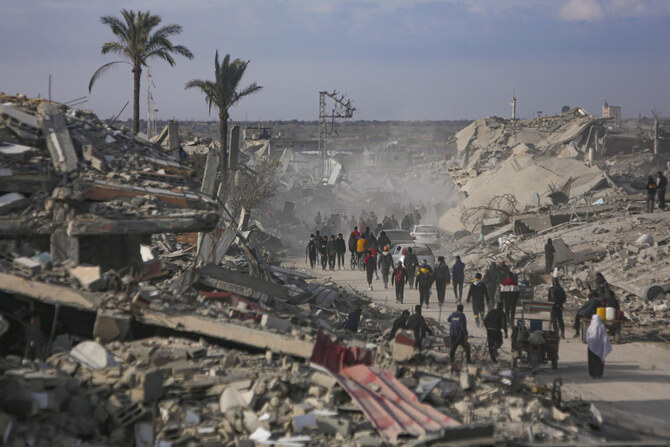BEIRUT: Hostilities between Iran-backed Hezbollah and the Israeli army entered their ninth month on Sunday, resulting in more casualties and the destruction of homes and properties in Lebanon’s border area.
Hezbollah attacked Israeli military sites in the occupied Golan Heights for a second successive day. Around 40 rockets were launched from Lebanese territory toward the Golan Heights.
Hezbollah said in a statement that its operation was in retaliation for Israeli attacks on the southern villages, especially the towns of Aitaroun and Markaba.
The operation targeted Israeli artillery positions in Zaoura in the occupied Syrian Golan Heights, and the soldiers deployed around it, with Katyusha rockets.
Israeli army radio reported “the detection of 10 missile launches on the Golan Heights, in addition to drones in Upper Galilee, coinciding with the sound of alarm sirens in the area of Majdal Shams and its surroundings in the Golan.”
Israeli media outlets reported “a significant fire in northern Golan following the landing of several rockets in open areas in Zaoura.”
An Israeli army spokesman said two drones fell in the northern Golan area. The army said there were no casualties, and the incident was under investigation.
The military conflict seems to be escalating and Hezbollah announced on Sunday morning that it had targeted “the Ramtha site in the hills of occupied Kfar Shuba in Lebanon with missiles, and hit it.”
Hezbollah’s recent attacks, according to a statement, have included “an aerial assault with a drone on a newly established artillery position, targeting the headquarters of an artillery battalion in Odem in the Golan Heights, as well as locations where the Israeli officers and soldiers were stationed, hitting them accurately.”
Another operation targeted Samaqa in the hills of Kfar Shuba with missiles.
Hezbollah said it had taken action against “the espionage equipment at the Ruwaisat Al-Alam site in the hills of Kfar Shuba.”
It also targeted “the Baraka Risha site and its garrison and espionage equipment with artillery shells and guided missiles.”
The group also struck at “the headquarters of the Sahel battalion in the Beit Hillel Barracks with missiles, as well as the sites of Al-Rahib and Al-Tayhat and buildings in Misgav Am and Kfar Yuval with appropriate weapons.”
Israeli attacks resumed on border towns under the control of Hezbollah, most notably Aytaroun.
A cafe in the town was hit by a drone and Ali Khalil Hamad, 37, and Radwan Ali Issa, from Houmin El-Tahta, were killed in the incident.
Israeli drones also targeted Hula and Taybeh while the outskirts of Naqoura and Al-Jabayn and the town of Khiam were hit by artillery shelling.
An Israeli drone targeting Khiam resulted in the death of paramedic Ahmed Ali Youssef, 21.
Israeli military aircraft continue to violate Lebanese airspace, with low-altitude flights recorded on Sunday over Beirut, and flights over the Keserwan region and northern areas of Lebanon taking place at medium altitudes.
Mohammad Raad, the head of Hezbollah's Loyalty to Resistance parliamentary bloc, has said that he doubts Israel can achieve any of its objectives.
He said: “On a national, moral, and humanitarian level, we must be strong in our country, and our strength must be employed to protect our country and all sectors of our people.
“If some blame us for being strong and continuing to build our strength and anticipating risks before they strike us, then we have no concern for them now. We must confront the real enemy that poses a threat.
“The resistance is present and stronger than ever before. It has destabilized and undermined Israel’s military bases and leadership headquarters.
“Israel is thinking about having a security belt in our land. It is now establishing one within occupied Palestine because it is unable to protect the settlers.”


























